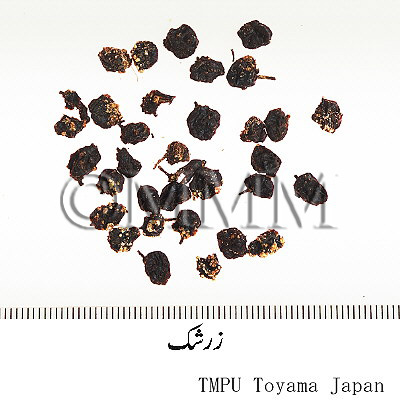Crude drug sample data base
※Click on the image to enlarge it.
The capital city, provincial capital city or the representative
location of its administrative area is indicated.
location of its administrative area is indicated.
Production area information
https://ethmed.toyama-wakan.net/img/pin_san.png
23.810332
90.41251809999994
Collection information
People's Republic of Bangladesh,Dacca [Dhaka]
https://ethmed.toyama-wakan.net/img/pin_nyu.png
Scientific information data base
| Crude drug name | Urudu name, English name | Zarishk, True barberry, Common barberry | |||
|---|---|---|---|---|---|
| Arabic name / Persian name | Amberbaris / Zarishk, Bedana | ||||
| crude drug image |
| ||||
| Original plant name | Berberis vulgaris Linn. | ||||
| Family name | Berberidaceae | ||||
| Used part | Fruits | ||||
| Distribution area | A member of the same genus Berberis met within Himalayas from Nepal and Tibet to Afghanistan. | ||||
| Description | The fruits of Berberis vulgaris are also called Zarishk. It has a large number of varieties e.g. round, red, sahili (coastal), black, rectangular, sandy or mountainous. The mountainous variety is the most potent. Egyptians and Syrians are also its varieties. Syrian variety is superior than Egyptia | ||||
| Function and properties | Swellings and pimples, Alimentary organs, Excretory organs, Fevers. It is attenuant. It is very strong for eradicating the yellow bile, tonic to stomach and liver, reduces the swellings of stomach and liver; also produces constipation. | ||||
| Specific actions | It is useful in the diseases caused by yellow bile. | ||||
| Frequency in use | Very common. | ||||
| Common uses | Swellings and pimples: When applied as plaster by virtue of its property, it is highly useful for severe inflammations. It also reduces the swellings of stomach and liver. In the hardness of liver it is used with saffron. Alimentary organs: It strengthens the stomach and liver and quenches the thirst. Excretory organs: It causes constipation, is useful in abrasions and when administered orally it checks the chronic flow of fluids from the uterus. It is said that when a woman smears her belly or strikes it thrice with the root of amberbaris, abortion takes place. It is useful in the bleeding from lower limbs of the body. It is also beneficial in dysentery. Fevers: The fruits are grounded in water and sieved; then this extract is given in fevers (due to yellow bile) and to check vomiting. It is also useful to stomach and liver weakness in the phlegmatic fevers. | ||||
| Side effect | It produces constipation in the intestines. It may harm to those individuals who have phlegmatic temperament. | ||||
| Medical system | Unani | ||||
| Traditional concept | Temperament | It is cold and dry in the last of the third degree (Avicenna). According to Ibn al-Baytar it is cold and dry in the second degree. | |||
| Drug effect | It is very beneficial in the diseases caused by yellow bile. | ||||
| Dosage | 2 to 5 gm. | ||||
| Substitute | Zarawand (Aristolochia longa Linn.) and Sandal Safaid (Santalum album Linn.). | ||||
| Related drugs | Berberis asiatica, B. lycium. | ||||
| Corrigent (corrective) | Shakar (table sugar) and Loang (Syzygium aromaticum Merr. & Perry), clove. | ||||
| Important compound preparations | Jawarish-Amla, Jawarish Zarishk, Jawarish Fawakih and Sherbat Fawakih. | ||||
| References | Reference book Tips! | Indian Materia Medica, Vols. 1-2, 1976 (Repr. 1989). Nadkarni, A.K., Popular Prakashan Pvt. Ltd., Bombay Vol. 1, pp 191-195. Makhzanul-Mufradat (Khawasul Adviyah), Hakeem Kabiruddin, Daftar Al-Masih, Qarol Bagh, Delhi. p 313. Dictionary of Economic Plants in India, 1996 (2nd Rep.). Singh, U; Wadhwani, A. M. and Johri B.M. Indian council of Agricultural Research, New Delhi. p 29. Al-Qanun Fil-Tibb. Avicenna. (English translation of the critical Arabic text), Book 2, 1998. Hameed, H. A. (editor), Dept. of Islamic Studies, Jamia Hamdard (Hamdard University), New Delhi. p 75. Al-Jamili Mufradt Al Adwiya Wal Aghziya (1197-1248 A.D.). Ibn al-Baytar. Vols. 1-3, 1985-1999. Central council for Research in Unani Medicine, Janakpuri, New Delhi. pp 131-132. Hamdard Pharmcopoeia of Eastern medicine, 1969. Said, H. M. (editor), The Times Press, Sadar Karachi. pp 79, 80-81, 88, 182. Indusyunic Medicine, 1997. Usmanghani, K., Saeed, A. and Alam, M. T. Department of Pharmacognosy, Faculty of Pharmacy, University of Karachi, Karachi. pp 120-122. | |||
| Remarks | There is some difference of opinion as to whether 'Rasaut' should be regarded as a specific preparation from the root or wood of B. lycium or from B. asiatica or the two together. Most of the preparations offered for sale are derived from a mixture of the two plants. Same is the case with the fruit - Amberbaris or Zarishk. It is obtained either from B. vulgaris only or from other species of Berberis. The fruits of B. vulgaris are edible. Fruit is a common bakery item. | ||||
| Last renewal date | 2024/03/19 | ||||



